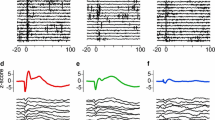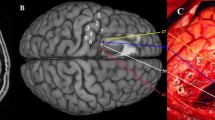Summary
In six chronic cats experiments were carried out to examine the motor effects elicited by microstimulation of the rostral portion of the corpus callosum (CC) which contains fibres interconnecting the motor cortices of the two hemispheres. Serial dorso-ventral penetrations were stereotaxically performed along the rostro-caudal extent of the CC at 0.25–0.5 mm intervals. Motor responses, consisting of very discrete contractions of shoulder, whisker and eyelid muscles, were obtained upon stimulation of about the most rostral 4 mm at intensities lower than 50 μA. At threshold the responses appeared in only one body region and were often unilateral. A light increase in current gave rise to symmetrical bilateral effects. Thresholds were the lowest in the middle of CC and gradually rose towards its dorsal and ventral surfaces. In the course of a penetration an effect once elicited persisted until either the threshold became higher than 50 μA or the ventral edge was reached. All motor effects had thresholds higher than 10 μA. Contractions of shoulder, whisker and eyelid muscles at a threshold lower than 20 μA were obtained in 62.7%, 25.7% and 54.3% of penetrations, respectively. Shoulder and eyelid muscles were represented in the rostral and caudal half of the effective zone, respectively, whereas the representation of whisker muscles overlapped with the other two in the rostral third or the middle part of the effective zone.
Single fibres driven by palpation of muscles responding to microstimulation or by movements of the joint mobilized by microstimulation were found at the most rostral sites, whereas units responding to hair displacement over or around the affected muscles were isolated mainly at the most caudal sites.
It was inferred that functionally homogeneous callosal fibres are clustered in bundles arranged in dorso-ventrally oriented laminae. The somatotopic representation of the motor effects elicited by microstimulation along the rostro-caudal extent of the effective zone should be the consequence of the serial arrangement of these partially overlapping laminae.
Similar content being viewed by others
References
Asanuma H, Arnolds A, Zarzecki P (1976) Further study on the excitation of pyramidal tract cells by intracortical microstimulation. Exp Brain Res 26: 443–461
Asanuma H, Babb RS, Waters RS (1981) Input-output relationships in cat's motor cortex after pyramidal section. J Neurophysiol 46: 694–703
Asanuma H, Hunsperger RW (1975) Functional significance of projection from the cerebellar nuclei to the motor cortex in the cat. Brain Res 98: 73–92
Asanuma H, Okamoto K (1959) Unitary study on evoked activity of callosal neurons and its effect on pyramidal tract cell activity on cats. Jpn J Physiol 9: 473–483
Asanuma H, Okuda O (1962) Effects of transcallosal volleys on pyramidal tract cell activity of cat. J Neurophysiol 25:198–208
Asanuma H, Sakata H (1967) Functional organization of a cortical efferent system examined with focal depth stimulation in cats. J Neurophysiol 30: 35–54
Asanuma H, Stoney SD, Jr, Abzug C (1968) Relationship between afferent input and motor outflow in cat motorsensory cortex. J Neurophysiol 31: 670–681
Berlucchi G (1972) Anatomical and physiological aspects of visual functions of corpus callosum. Brain Res 37: 371–392
Berlucchi G, Gazzaniga SM, Rizzolatti G (1967) Microelectrode analysis of transfer of visual information by the corpus callosum. Arch Ital Biol 105: 583–596
Caminiti R, Innocenti GM, Manzoni T (1979) The antomical substrate of callosal messages from SI and SII in the cat. Exp Brain Res 35: 296–314
Catsman-Berrevoets CE, Lemon RN, Verburgh CA, Bentivoglio M, Kuypers HGJM (1980) Absence of callosal collaterals derived from rat corticospinal neurons. A study using fluorescent retrograde tracing and electrophysiological techniques. Exp Brain Res 39: 433–440
Ebner FF, Myers RE (1965) Distribution of corpus callosum and anterior commissure in cat and raccoon. J Comp Neurol 124: 353–366
Feeney DM, Orem JM (1971) Influence of antidromic callosal volleys on single units in visual cortex. Exp Neurol 33: 310–321
Goldman PS, Nauta WJH (1977) Columnar distribution of corticocortical fibers in the frontal association, limbic, and motor cortex of the developing rhesus monkey. Brain Res 122: 393–413
Hubel DH, Wiesel TN (1967) Cortical and callosal connections concerned with the vertical meridian of visual field in the cat. J Neurophysiol 30: 1561–1573
Innocenti GM, Fiore L (1976) Morphological correlates of visual field transformation in the corpus callosum. Neurosci Lett 2: 245–252
Innocenti GM, Manzoni T, Spidalieri G (1974) Patterns of the somesthetic messages transferred through the corpus callosum. Exp Brain Res 19: 447–466
Jacobson S, Trojanowski JQ (1974) The cells of origin of the corpus callosum in rat, cat, and rhesus monkey. Brain Res 74: 149–155
Jankowska E, Padel Y, Tanaka R (1975) The mode of activation of pyramidal tract cells by intracortical stimuli. J Physiol (Lond) 249: 617–636
Jenny AB (1979) Commissural projections of the cortical hand motor area in the monkeys. J Comp Neurol 188: 137–146
Jones EG, Coulter JD, Wise SP (1979) Commissural columns in the sensory-motor cortex of monkeys. J Comp Neurol 188: 113–136
Jones EG, Powell TPS (1968) The commissural connections of the somatic sensory cortex in the cat. J Anat (Lond) 103: 433–455
Jones EG, Powell TPS (1969) Connections of the somatic sensory cortex of the rhesus monkey. II. Contralateral cortical connections. Brain Res 92: 717–730
Kawamura K (1971) Variations of the cerebral sulci in the cat. Acta Anat 80: 204–221
Kawamura K, Otani K (1970) Corticocortical fiber connections in the cat cerebrum: The frontal region. J Comp Neurol 139: 423–448
Klüver H, Barrera E (1953) A method for the combined staining of cells and fibers in the nervous system. J Neuropathol Exp Neurol 12: 400–403
Künzle H (1976) Alternating afferent zones of high and low axon terminal density within the macaque motor cortex. Brain Res 106: 365–370
Lamarre Y, Joffroy AJ, Filion M, Bouchoux R (1970) A stereotaxic method for repeated sessions of central unit recording in the paralysed or moving animal. Rev Can Biol 29: 371–376
Luttemberg J, Marsala J (1963) Localization of Commissural fibers in the corpus callosum in the cat's brain. Czech J Morph 11: 166–176
Manzoni T, Barbaresi P, Bellardinelli E, Caminiti R (1980) Callosal projections from the two body midlines. Exp Brain Res 39: 1–9
Matsunami K, Hamada I (1981) Characteristics of the ipsilateral movement-related neuron in the motor cortex of the monkey. Brain Res 204: 29–42
McGuinness E, Sivertsen D, Allman JM (1980) Organization of the face representation in macaque motor cortex. J Comp Neurol 193: 591–608
Naito H, Miyakawa F, Ito N (1971) Diameter of callosal fibers interconnecting cat sensorimotor cortex. Brain Res 27: 369–372
Nakamura K, Naito H, Kurosaki T, Tamura Y (1971) Effect of polarising currents on transcallosal postsynaptic potentials of cat pyramidal tract cells. Brain Res 35: 547–550
Pandya DN, Vignolo LA (1971) Intra-and interhemispheric projections of the precentral, premotor and arcuate areas in the rhesus monkey. Brain Res 26: 217–233
Pappas CL, Strick PL (1981a) Physiological demonstration of multiple representation in the forelimb region of the cat motor cortex. J Comp Neurol 200: 481–490
Pappas CL, Strick PL (1981b) Anatomical demonstration of multiple representation in the forelimb region of the cat motor cortex. J Comp Neurol 200: 491–500
Purpura DP, Girado M (1959) Synaptic mechanisms involved in transcallosal activation of corticospinal neurons. Arch Ital Biol 97: 111–139
Reighard J, Jennings HS (1935) Anatomy of the cat, 3rd edn. Holt, New York
Spidalieri G, Guandalini P (1982) Motor responses produced by microstimulation of the rostral portion of the corpus callosum in the cat. Neurosci Lett [Suppl] 10: 459
Stoney SD, Jr, Thompson WD, Asanuma H (1968) Excitation of pyramidal tract cells by intracortical microstimulation: effective extent of stimulating current. J Neurophysiol 31: 659–669
Author information
Authors and Affiliations
Additional information
Supported by grants from the National Research Council (CNR) of Italy and from Italian Ministere della Pubblica Istruzione
Rights and permissions
About this article
Cite this article
Spidalieri, G., Guandalini, P. Motor representation in the rostral portion of the cat corpus callosum as evidenced by microstimulation. Exp Brain Res 53, 59–70 (1983). https://doi.org/10.1007/BF00239398
Received:
Issue Date:
DOI: https://doi.org/10.1007/BF00239398




